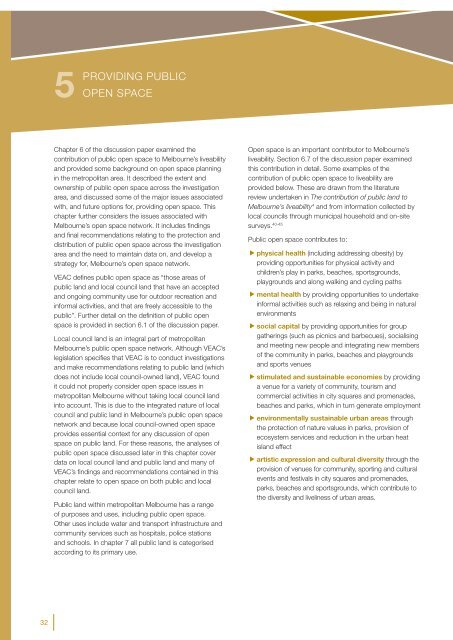Metropolitan Melbourne Investigation - Victorian Environmental ...
Metropolitan Melbourne Investigation - Victorian Environmental ...
Metropolitan Melbourne Investigation - Victorian Environmental ...
You also want an ePaper? Increase the reach of your titles
YUMPU automatically turns print PDFs into web optimized ePapers that Google loves.
5<br />
PROVIDING PUBLIC<br />
OPEN SPACE<br />
Chapter 6 of the discussion paper examined the<br />
contribution of public open space to <strong>Melbourne</strong>’s liveability<br />
and provided some background on open space planning<br />
in the metropolitan area. It described the extent and<br />
ownership of public open space across the investigation<br />
area, and discussed some of the major issues associated<br />
with, and future options for, providing open space. This<br />
chapter further considers the issues associated with<br />
<strong>Melbourne</strong>’s open space network. It includes findings<br />
and final recommendations relating to the protection and<br />
distribution of public open space across the investigation<br />
area and the need to maintain data on, and develop a<br />
strategy for, <strong>Melbourne</strong>’s open space network.<br />
VEAC defines public open space as “those areas of<br />
public land and local council land that have an accepted<br />
and ongoing community use for outdoor recreation and<br />
informal activities, and that are freely accessible to the<br />
public”. Further detail on the definition of public open<br />
space is provided in section 6.1 of the discussion paper.<br />
Local council land is an integral part of metropolitan<br />
<strong>Melbourne</strong>’s public open space network. Although VEAC’s<br />
legislation specifies that VEAC is to conduct investigations<br />
and make recommendations relating to public land (which<br />
does not include local council-owned land), VEAC found<br />
it could not properly consider open space issues in<br />
metropolitan <strong>Melbourne</strong> without taking local council land<br />
into account. This is due to the integrated nature of local<br />
council and public land in <strong>Melbourne</strong>’s public open space<br />
network and because local council-owned open space<br />
provides essential context for any discussion of open<br />
space on public land. For these reasons, the analyses of<br />
public open space discussed later in this chapter cover<br />
data on local council land and public land and many of<br />
VEAC’s findings and recommendations contained in this<br />
chapter relate to open space on both public and local<br />
council land.<br />
Public land within metropolitan <strong>Melbourne</strong> has a range<br />
of purposes and uses, including public open space.<br />
Other uses include water and transport infrastructure and<br />
community services such as hospitals, police stations<br />
and schools. In chapter 7 all public land is categorised<br />
according to its primary use.<br />
Open space is an important contributor to <strong>Melbourne</strong>’s<br />
liveability. Section 6.7 of the discussion paper examined<br />
this contribution in detail. Some examples of the<br />
contribution of public open space to liveability are<br />
provided below. These are drawn from the literature<br />
review undertaken in The contribution of public land to<br />
<strong>Melbourne</strong>’s liveability 4 and from information collected by<br />
local councils through municipal household and on-site<br />
surveys. 40-45<br />
Public open space contributes to:<br />
G physical health (including addressing obesity) by<br />
providing opportunities for physical activity and<br />
children’s play in parks, beaches, sportsgrounds,<br />
playgrounds and along walking and cycling paths<br />
G mental health by providing opportunities to undertake<br />
informal activities such as relaxing and being in natural<br />
environments<br />
G social capital by providing opportunities for group<br />
gatherings (such as picnics and barbecues), socialising<br />
and meeting new people and integrating new members<br />
of the community in parks, beaches and playgrounds<br />
and sports venues<br />
G stimulated and sustainable economies by providing<br />
a venue for a variety of community, tourism and<br />
commercial activities in city squares and promenades,<br />
beaches and parks, which in turn generate employment<br />
G environmentally sustainable urban areas through<br />
the protection of nature values in parks, provision of<br />
ecosystem services and reduction in the urban heat<br />
island effect<br />
G artistic expression and cultural diversity through the<br />
provision of venues for community, sporting and cultural<br />
events and festivals in city squares and promenades,<br />
parks, beaches and sportsgrounds, which contribute to<br />
the diversity and liveliness of urban areas.<br />
32
















